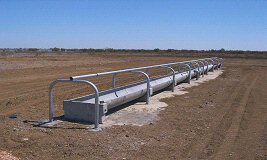An Introduction to Sacrificial Anodes |
What are anodes and how do they work? The corrosion (rust) is the result of electrolytic action travelling through moisture or fluid to home in on the metal surface at risk. Depending upon the existing conditions such as amount and quality of the fluid (water?) and the effective presence of any other protective coating on the metal surface, the rate of anode corrosion can vary substantially. For fresh and groundwater applications our anodes are of a particular
grade of magnesium which is "electro-negative relative to steel" which
means that they will attract the destructive electrolytic action on
to themselves. This type of galvanic protection is called sacrificial
and the principle of electrolytic corrosion control is called cathodic
protection. Because cathodic surfaces cannot rust,
the steel surface is protected. |
|
|
 Anodes will protect a multitude of steel structures in rural applications. |
For steel water tanks without an internal liner, very effective protection can be provided by the insertion of special tank anodes supplied complete with end mounting brackets suitable for either bolting or welding directly to the inside walls below the water level. Alternatively anodes are available which are designed to be suspended from the tank’s roof frame. |
|

